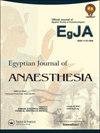Comparative study between dexmedetomidine and fentanyl as adjuvants to bupivacaine for postoperative epidural analgesia in abdominal surgeries: A randomized controlled trial
IF 0.5
Q3 ANESTHESIOLOGY
引用次数: 0
Abstract
ABSTRACT Background Epidural analgesia is an efficient strategy to relieve postoperative pain after abdominal surgeries. This study aimed to evaluate dexmedetomidine or fentanyl when added to bupivacaine, providing postoperative epidural analgesia after abdominal procedures. Patients and methods Epidural catheter was placed on 75 patients scheduled for lower abdominal procedures under general anesthesia, and they were randomly assigned into three equal groups. Epidural analgesia was activated before the procedure was completed by injection of bupivacaine (0.125%) plus dexmedetomidine or fentanyl or normal saline mixture, according to the study groups. After complete recovery from general anesthesia, the epidural block was evaluated. Then, the infusion started through an elastomeric pump with an infusion rate of 5 ml/hr and continued for 24 hr postoperatively. Group D Dexmedetomidine 1 ml (100 μg) plus normal saline 1 ml were added to bupivacaine (0.125%) 48 ml (a total volume of 50 ml). Group F: 2 ml (100 μg) fentanyl was added to bupivacaine (0.125%) 48 ml (a total volume of 50 ml). Group C: Normal saline 2 ml was added to bupivacaine (0.125%) 48 ml (a total volume of 50 ml). Measured outcomes Primary outcomes The onset of sensory analgesia (from the beginning of epidural infusion until scoring 1 on a 3-point scale) and the duration of analgesia (from the start of epidural infusion till the first demand for further pain medication) were observed and recorded. Secondary outcomes Postoperative pain was evaluated using a visual analogue scale (VAS), and the number of patients requesting additional analgesia with pethidine over paracetamol as well as the pethidine consumption during postoperative 24 hr were recorded. The hemodynamic parameters, including heart rate (HR) and mean arterial blood pressure (MAP), were monitored and recorded at baseline, 2, 6, 12, and 24 hr, and any adverse events were properly recorded and managed during the study period. Results The dexmedetomidine group showed an earlier onset and longer duration of analgesia, with a highly significant difference (P-value <0.001) than other groups. The study groups differed significantly concerning pethidine needs and consumption (P-value <0.05). The VAS revealed a considerable decrease in the dexmedetomidine group compared to other groups, with a significant difference (P-value <0.05) at the intervals of (baseline, 12 hr, and 24 hr) and a highly significant difference (P-value <0.001) at the intervals of (2 and 6 hr). Postoperative blood pressure and heart rate measurements in the dexmedetomidine group were lower than in other groups. MAP showed a statistically highly significant difference at 6 and 24 hr (P-value <0.001) and a significant difference after 12 hr (P-value <0.05), while HR showed a statistically significant difference after 6 hr (P-value <0.05) and a highly significant difference at 12 and 24 hr (P-value <0.001). Regarding postoperative adverse events, no statistical difference was detected between groups except in pruritis and dry mouth. Conclusion Dexmedetomidine is preferred to fentanyl when added to epidural bupivacaine to relieve pain after abdominal procedures.右美托咪定与芬太尼辅助布比卡因用于腹部手术术后硬膜外镇痛的比较研究:一项随机对照试验
本文章由计算机程序翻译,如有差异,请以英文原文为准。
求助全文
约1分钟内获得全文
求助全文
来源期刊

Egyptian Journal of Anaesthesia
Medicine-Anesthesiology and Pain Medicine
CiteScore
0.90
自引率
0.00%
发文量
78
 求助内容:
求助内容: 应助结果提醒方式:
应助结果提醒方式:


